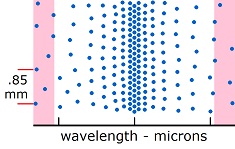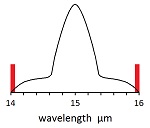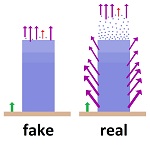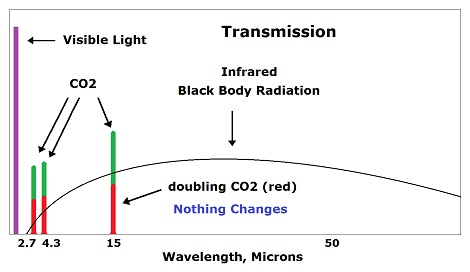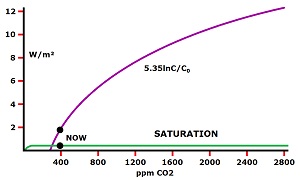Saturation Proves Global Warming is not Possible There are 2,500 air molecules around each CO2 molecule. That means each CO2 molecule would need to be 2,500°C to heat the air 1°C. It's not possible. All attempts to describe a mechanism fail and contradict each other. Because of saturation, radiation gets used up by the time it travels a few meters in the atmosphere. Supposedly, edge molecules are thinner and allow more distance? Like where to? To the top of the atmosphere? The molecules would have to be almost a millimeter apart to allow radiation to get to the top of the troposphere (normal atmosphere) from ground level for carbon dioxide.
"Radiative transfer equations" (RTE) were used as a method of going around saturation without accounting for it. Supposedly, saturation effects are included in RTE, but they aren't. RTE uses extremely small slices to evaluate radiation, and then adds up the slices. The overlap between slices disappears in that analysis, and it is the overlap which creates saturation. The concept of saturation was brought up by critics long after fake scientists were telling us how much heat carbon dioxide would add to the atmosphere. The prevailing assumption is that radiative transfer equations take care of everything, and the effects of saturation are included in the outcome. So the explanations for saturation are trivial brush-offs without credibility. Since the unsaturation of shoulder molecules cannot be explained, it never is. It's a phantom subject. It goes no farther than a few empty words. Here's how it was said in the IPCC documents in 2001 (never to be mentioned again that I'm aware of): "Carbon dioxide absorbs infrared radiation in the middle of its 15 mm [sic] band to the extent that radiation in the middle of this band cannot escape unimpeded: this absorption is saturated. This, however, is not the case for the band’s wings. It is because of these effects of partial saturation..." You might think there is an ocean of science with that statement. There is none. It ends there. reference: IPCC, AR3, 1.3.1, 2001. The counter-argument by alarmists denying saturation. The rationalization for non-saturation is that saturation does indeed occur all the way up to some high altitude in the atmosphere; but somewhere up there, gases are so thin that they do not saturate, and escape of radiation is easier up there. The temperature increase supposedly occurs in that high zone. Notice that alarmists are looking for a non-saturated area, admitting that everything below it is saturated and admitting that heating does not directly occur where there is saturation. Then two variations exist for the next step of the argument, which is, how does the heat get back to the surface? One argument is that it radiates back. Numbers show that extreme heat would be needed high up to produce slight warming near the surface through "back radiation". An increase of 24°C would be needed at a height of 9 kilometers to radiate enough heat downward to heat the near surface 1°C, and much more when considering that oceans absorb and do not readily release 70% of the radiation. No temperature increase has been detected high up in the atmosphere.
There is a tendency for alarmist rationalizers to go for a 9 km layer in the atmosphere where everything happens. Saturation is still total at 9 km. With the center of the band absorbing in 10 meters, one thousandth of the total still saturates at 10 kilometers. This means 99.9% of the CO2 molecules are saturated below the top of the normal atmosphere (troposphere). The concern would have to be one part per two thousand of the CO2 molecules to be non-saturated, which is one CO2 molecule doing the heating while surrounded by 5 million other molecules (1/2000 x 400 ppm = 1/5 million). A persistent absurdity permeating this whole subject is that the effects being rationalized are of such miniscule quantities that they would be irrelevant even if everything else were true about them. Anything carbon dioxide could do at the top of the atmosphere would be so miniscule it could never be noticed, and nothing up there has ever changed in a detectable way. A look at the counter-argument for saturation shows the whole point of this book, which is that slopping a few words around on an extremely superficial point is allowed to contradict or substitute for 500 years of developed scientific knowledge. Nothing in this area can be properly represented with the superficial points being argued, particularly in isolation from oceans of surrounding influences which are not considered. When looking at everything in climatology, scientists do not have the slightest ability to evaluate the complexities which they are dealing with. The mentality of single-point analysis through mathematics ran away with physics around 1900. It is never a valid approach to science, because natural phenomena are never made of isolated points. The product of the radiative transfer equations is a fudge factor: 5.35 ln C/C0. The fudge factor is absurd, as it never does saturate, which would be a horizontal line. Even if the "wings" were unsaturated now, they would have to saturate as concentrations increase, while the fudge factor never does saturate. (Fudge Factor Details) |
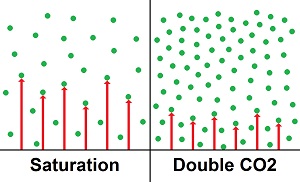
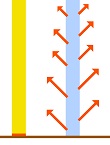 (Global warming does not occur, because the earth is cooled by radiation which goes around greenhouse gases until equilibrium is established with energy from the sun.)
(Global warming does not occur, because the earth is cooled by radiation which goes around greenhouse gases until equilibrium is established with energy from the sun.)